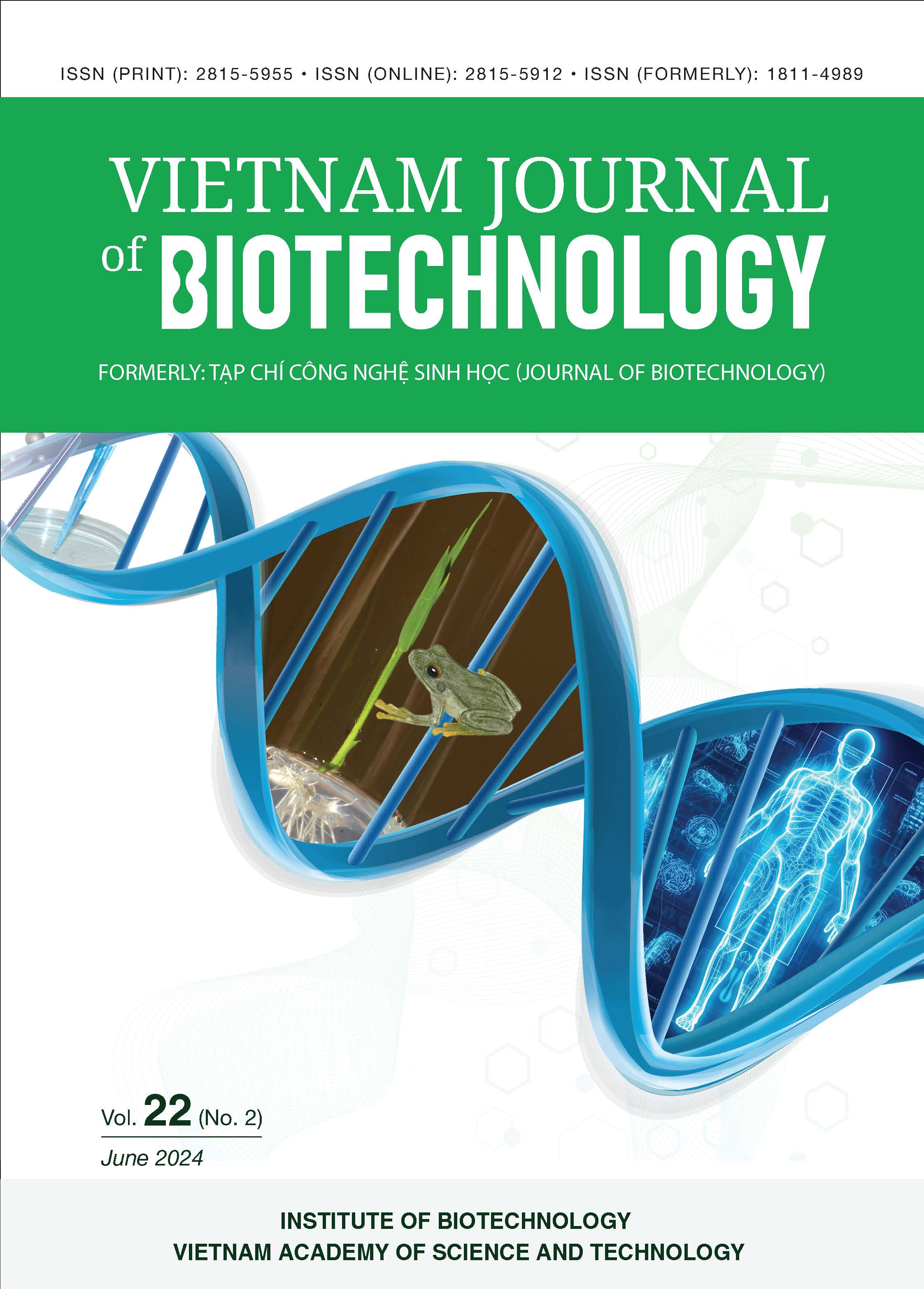A colorimetric multiplex RPA approach for on-site dual monitoring of Vibrio parahaemolyticus and White Spot Syndrome Virus in Pacific Whiteleg shrimp
Author affiliations
DOI:
https://doi.org/10.15625/vjbt-19569Keywords:
colorimetric, multiplex RPA, WSSV, V. parahaemolyticusAbstract
White spot syndrome virus (WSSV) and Vibrio parahaemolyticus represent the most prevalent and serious pathogens in Viet Nam's shrimp industry, annually inflicting major production losses. With no existing therapeutic measures, timely and accurate diagnosis is imperative for curbing outbreaks and limiting economic impacts through isolation and culling protocols. However, conventional techniques like polymerase chain reaction (PCR) and quantitative PCR require advanced laboratory infrastructure that is incompatible with rapid on-site pathogen surveillance. This work details the development of a multiplex recombinase polymerase amplification (RPA) assay for the simultaneous detection of WSSV and V. parahaemolyticus using a visual colorimetric readout amenable to field deployment. Primers targeting unique WSSV and V. parahaemolyticus sequences were designed for selective amplification. Specificity screening verified exclusive pathogen detection against common shrimp microbiota and human-handling contaminants with no cross-reactivity. Singleplex reactions identified 39 °C for 35 minutes as optimal conditions; hence, these parameters were subsequently applied in multiplex format. Incorporation of the Mg2+-sensitive eriochrome black T (EBT) dye enabled clear discrimination between positive blue and negative violet reactions by the naked eye. The multiplex assay demonstrated high analytical sensitivity, down to 1 copy of DNA template per reaction. Clinical validation of the multiplex RPA method using shrimp samples versus quantitative PCR showed 100% agreement. By coupling rapid isothermal amplification with visual indicator-based detection in a multiplexed format, this assay provides simple, robust, and user-friendly identification of major shrimp pathogens in resource-limited settings in less than one hour to facilitate prompt on-site disease control decisions. The field-suitable platform aims to mitigate outbreak magnitude and economic consequences through timely response.
Downloads
References
Beatriz O, Bruno V, Pedro B (2021) Isothermal amplification of nucleic acids: The race for the next “gold standard”. Front Sens 2: 752600. https://doi.org/10.3389/fsens.2021.752600.
Caipang CMA, Aguana MPN (2010) Rapid diagnosis of vibriosis and white spot syndrome (WSS) in the culture of shrimp, Penaeus monodon in Philippines. Vet Res Commun 34(7): 597-605. https://doi.org/10.1007/s11259-010-9434.
Huyen HM, Hoa TTT (2014) Development of a multiplex PCR procedure for the detection of White Spot Syndrome Virus (WSSV) and Vibrio harveyi infections in farmed shrimp. Can Tho University Journal of Science, Fisheries Issue 2014: 24-28.
Huyen HM, Ngoc LTK, Khanh NQ, Nhan NQ, Nhut PM, Hoa TTT (2022) Duplex PCR procedure for simultaneous detection of Vibrio parahaemolyticus and White Spot Syndrome Virus (WSSV) causing diseases in marine shrimp. Ha Long University Journal of Science 06: 99-109.
Ivan L, Ciara O (2018) Recombinase polymerase amplification: basics, applications and recent advances. Trends Analyt Chem 98: 19-35. https://doi.org/10.1016/j.trac.2017.10.015.
Joyanta B, Pallabi H, Sunuram R, Shamima S, Sarker K, Ghausiatur B (2017) A critical review on White Spot Syndrome Virus (WSSV): A potential threat to shrimp farming in Bangladesh and some Asian Countries. Int J Microbiol Mycol 6: 39-48.
Leal CAG, Carvalho AF, Leite RC, Figueiredo HCP (2014) Development of duplex real-time PCR for the detection of WSSV and PstDV1 in cultivated shrimp. BMC Vet Res 10: 150. https://doi.org/10.1186/1746-6148-10-150.
Lo CF, Ho CH, Peng SE, Chen CH, Hsu HC, Chiu YL, Chang CF, Liu KF, Su MS, Wang CH, Kou GH (1996) White Spot Syndrome Baculovirus (WSBV) detected in cultured and captured shrimp, crabs and other Arthropods. Diseases Aquat Org 27: 215-225. https://doi.org/10.3354/dao027215.
Mai HN, Caro LFA, Cruz-Flores R, Dhar AK (2021) Development of a Recombinase Polymerase Amplification (RPA) assay for acute hepatopancreatic necrosis disease (AHPND) detection in Pacific white shrimp (Penaeus vannamei). Mol Cell Probes 57: 101710. https://doi.org/10.1016/j.mcp.2021.101710.
Meiying T, Chuan L, Lina L, Xueli Y, Zihan Z, Guijiang W (2022) Recent advances in recombinase polymerase amplification: Principle, advantages, disadvantages and applications. Front Cell Infect Microbiol 12: 1019071. https://doi.org/10.3389/fcimb.2022.1019071.
Nazmul H, Tanjia AC, Mahmudul H, Kazi FA, Sayadatunnasa J, Muhammad FR, Mahbubur R, Saneya RS (2021) Genomic attributes and recent advances in detection of White Spot Syndrome Virus in shrimp: a review. Mar Bio Res 17: 794-814. https://doi.org/10.1080/17451000.2021.2023191.
Ngo NV, Pham TTH, Le NMT, Do NPC, Hoang T, Nguyen TTH (2017) Investigating the production of extracellular enzymes of Vibrio parahaemolyticus strains isolated in Viet Nam. J Biotechnol 15: 703-710. https://doi.org/10.15625/1811-4989/15/4/13413.
Saurabh T, Barbora L, Carlotta G (2022) Recombinase polymerase amplification in minimally buffered conditions. Biosens Bioelectron 198: 113802. https://doi.org/10.1016/j.bios.2021.113802.
Shin-Jen L, Kai-Cheng H, Hao-Ching W (2017) Structural insights into the cytotoxic mechanism of Vibrio parahaemolyticus PirAvp and PirBvp toxins. Mar Drugs 15: 373. https://doi.org/10.3390/md15120373.
Thi-Huyen T, Hoang-Anh PT, Loc T (2019) Establish the initial procedure for detecting Vibrio parahaemolyticus in the shrimp by One step-PCR method. J Sci Tech - IUH 39A(3): 40-47. https://doi.org/10.46242/jst-iuh.v39i03.276.
Xupeng H, Liqun L, Dan X (2016) Progress in Research on acute hepatopancreatic necrosis disease (AHPND). Aquacult Int 24: 577-593. https://doi.org/10.1007/s10499-015-9948-x.
Yinhua Z, Eric AH, Esta T, Ivan RCJ, Nathan AT (2022) Improved visual detection of DNA amplification using pyridylazophenol metal sensing dyes. Comm Bio 5: 999. https://doi.org/10.1038/s42003-022-03973-x
Yu H, Yang X, Zhang J, Yang H, Zhao P, Shen H, Jiang G, Ji J, Dong J, Gao S (2021) A rapid real-time recombinase polymerase amplification assay for diagnosis of acute hepatopancreatic necrosis disease in shrimp. Acta Bioch Bioph Sin 53(3): 381-384. https://doi.org/10.1093/abbs/gmaa175.
Yu-Ling S, Chug-Lun L, Chia-Hung L, En-I T, Chih-Sheng L (2023) Using Loop-mediated Isothermal Amplification combined with gold nanoparticles for optically rapid detection of shrimp Vibrio parahaemolyticus. J Food Saf 43: e13036. https://doi.org/10.1111/jfs.13036.
Zhang T, Liu X, Yang X, Liu F, Yang H, Li X, Feng H, Wu X, Jiang G, Shen H, Dong J (2022) Rapid on-site detection method for White Spot Syndrome virus using recombinase polymerase amplification combined with lateral flow test strip technology. Front Cell Infect Microbiol 12: 889775. https://doi.org/10.3389/fcimb.2022.889775.







